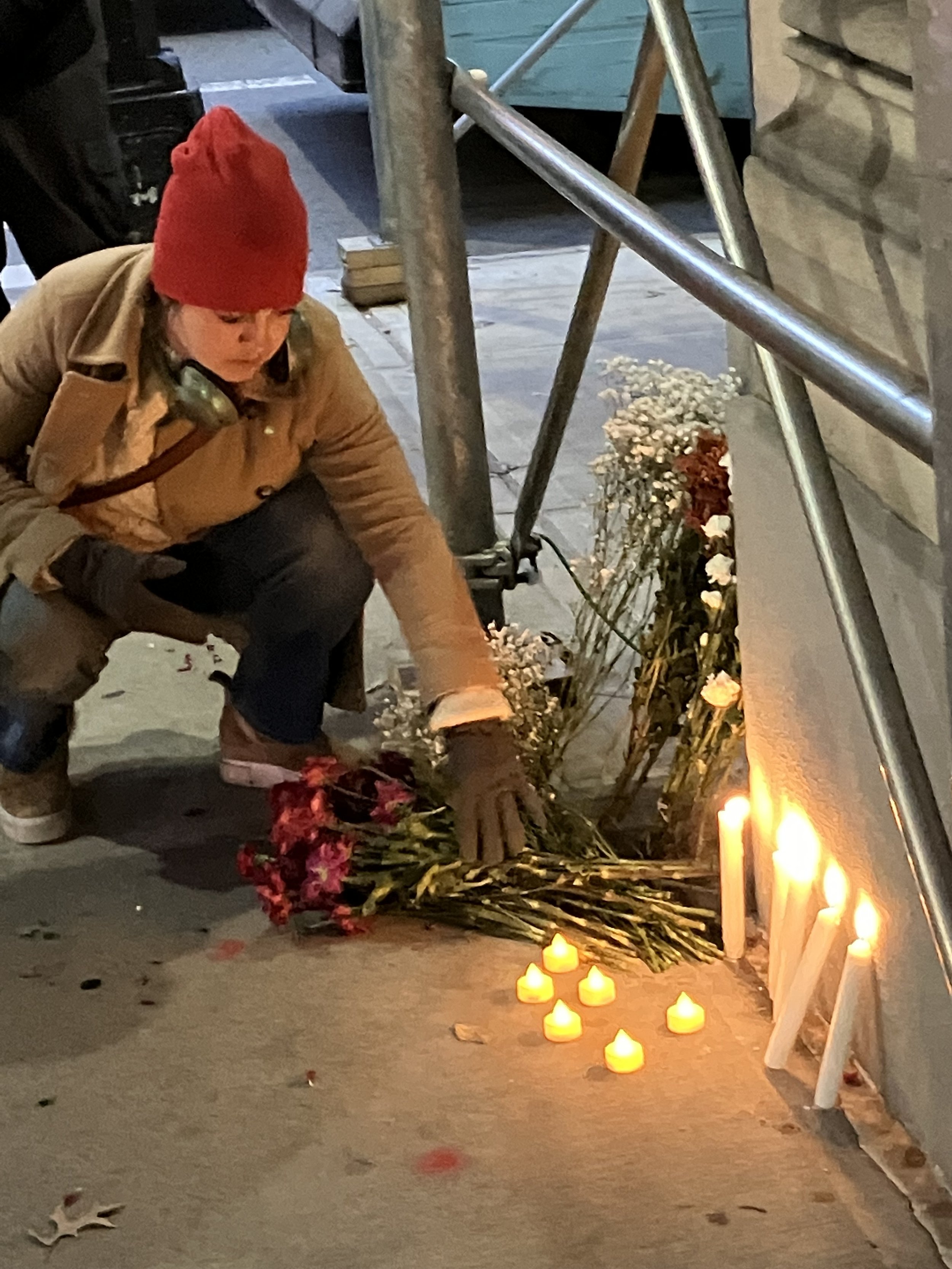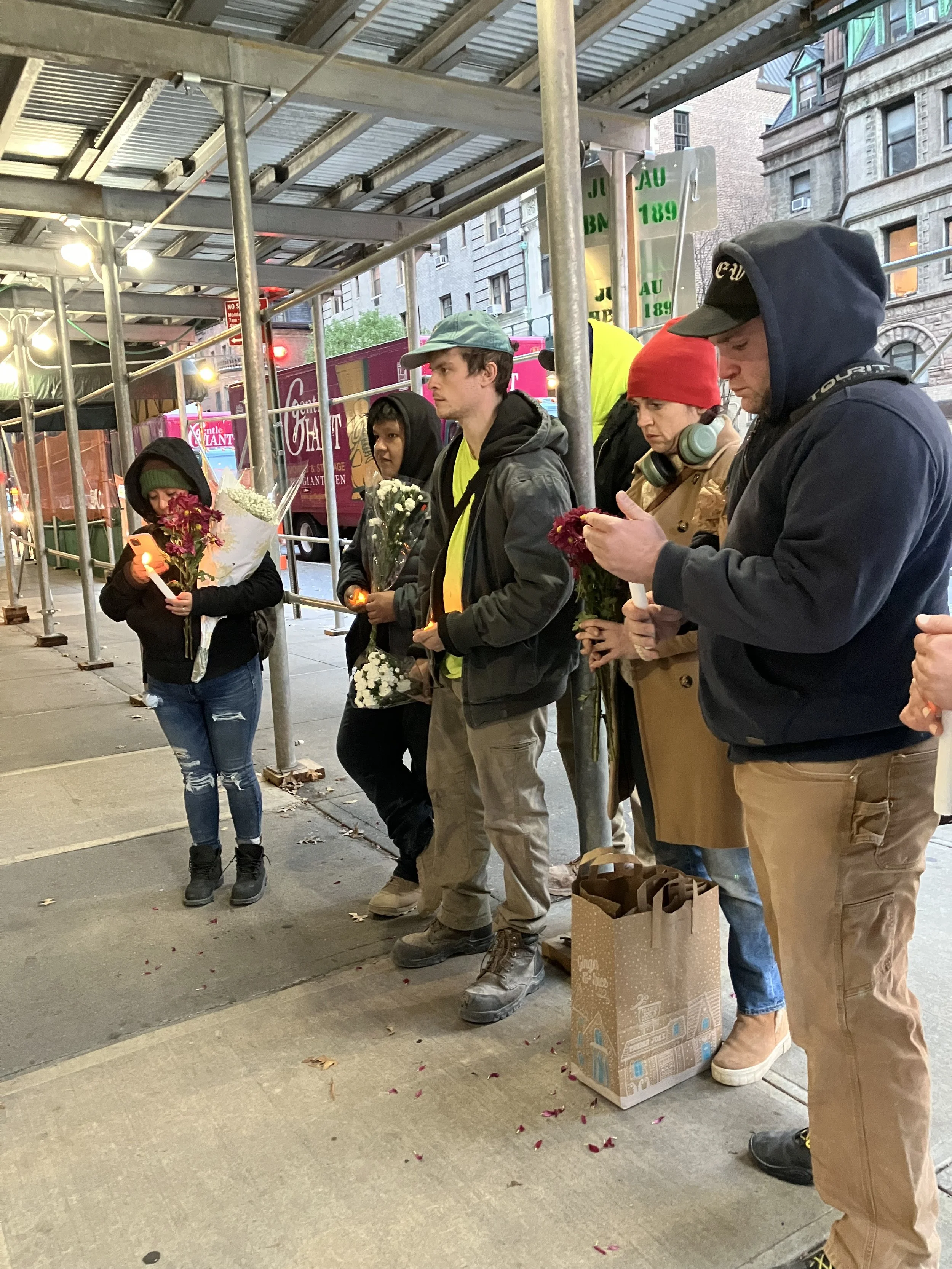A Construction Worker DIED HERE…
Members of the New York City Building Trades leave flowers in front of the building where fellow construction worker Ivan Frias was killed on the job Nov. 28. Photos by Joe Maniscalco
By Joe Maniscalco
Sometimes, jobs can get so bad they kill. Ivan Frias, went to work last Monday November 28, and never came home again after plunging off the 15th Floor of a 23-story building located at West 72nd Street and West End Avenue in Manhattan.
The 36-year-old New Rochelle man was the third New York City construction worker to die on the job last month alone. According to the Department of Buildings, there have been eight construction worker fatalities in the city so far this year.
There’s a bill called Carlos’ Law sitting on Democratic Governor Kathy Holchul’s desk that seeks to penalize criminal developers $500,000 for failing to maintain safe working conditions. Today, however, the cost of a construction worker’s life in New York City remains $10K — chump change for the fat cat “job creators” in the real estate industry who continue to hold sway in this town — no matter who’s in City Hall.
Candlelight Vigil For The Fallen
Shaken Building Trades workers attending a candlelight vigil for Frias outside 263 West End Avenue the day after his death weren’t content to wait on the needed legislation.
“It doesn’t have to be this way,” Percy Lujan, a member of Building Trades for Workers’ Democracy told the gathering. “It is up to us to make sure our jobs are safe. This is why we organize. The union movement and the organized workers movement in general does not end at the union hall — it becomes alive and true when we walk into our job sites and make sure we are protecting each other.”
IBEW Local 3 electrician Jimmy Giannone put it more bluntly: “We all have a voice — if you don’t think something is safe — don’t do it. I don’t give a f**k who says it. They try to pressure you, you have a voice. You have your own body. You have your own life — just don’t do it. Even an inkling of not being safe.”
The fifth-year apprentice was choking back thick emotions and thinking about his two kids at home when he talked to Work-Bites at the conclusion of the Frias vigil.
“Stuff like this is hard,” he said. “Another worker is not going home to his family. I think people are just going to have to get mad. There is no ‘both sides’ argument when it comes to this shit.”
Frias was in the employ of a non-unionized scaffolding outfit called Rennon Construction Corp. when he was killed working on 263 West End Avenue’s facade last week. The general contractor of the overall site is J & S Waterproofing.
A candlelight vigil in honor of 36-year-old construction worker Ivan Frias was held in front of 263 West End Avenue in Manhattan last Tuesday.
The New York City Department of Buildings, as it does following deaths like this, issued a stop work order on the site. It’s still investigating what happened at the time of this writing. Additional enforcement action, as they also say following construction worker deaths and injuries like this, are pending further investigation.
“Construction workers in our City deserve a safe working environment, and incidents like this week’s fatal fall are completely unacceptable,” DOB Deputy Press Secretary Ryan J. Degan said in a statement following Frias’ death.
The agency has recorded 44 construction worker fatalities since 2018.
Another trade unionist moved to speak at last week’s candlelight vigil said developers and their contractors solely concerned with “deadlines, losing money, and doing it cheaper and faster” are “missing the entire point” of building in this town.
“We’re here to build things that are useful to people,” she said. “We’re here to build communities. We build cities and we build solidarity. Every time someone on these job sites dies and it’s barely recognized — you miss the whole point of what it is we’re trying to do.”
“Things Are Pretty Damned Bad Now”
Statistics consistently show non-union construction sites — or so-called “open shop” developments — are more dangerous than union job sites.
New York City, however, doesn’t do a very good job of tracking the status of work sites following on-the-job accidents and fatalities — and it never has. Local Law 78, only enacted in 2017, requires contractors to report the union or non-union status of construction workers killed or seriously injured on the job within three days of an incident as part of a larger questionnaire.
But here again, there’s not much incentive to comply with the letter of the law — in this case, the maximum fine is $5K.
The DOB has not yet posted Local Law 78 reporting for November.
The New York State Legislature passed Carlos’ Law last summer. The measure increasing the fine for criminal liability to no less than $500,000 honors the memory of 22-year-old construction worker Carlos Moncayo who was killed in a Manhattan trench collapse seven years ago.
Mike McGuire, director of the Mason Tenders District Council Political Action Committee, has been involved in lots of legislative battles over the last 25-years and expects the measure to finally become law soon.
“They had one concern,” McGuire told Work-Bites. “The last version had two levels; one for killing a worker, and one for grievous injury. We didn’t define grievous injury. Construction is a dangerous industry — somebody gets a gash on his arm we don’t need the contractor in charge of the job to be fined $300,000 for that, unless there was some criminality. So, we’re gonna define grievous injury, and once we do that we expect it’ll be signed before the end of the year.”
At $500,000 for criminal liability and $300,000 for a misdemeanor, McGuire says penalties have now been set high enough to be a “real world deterrent to bad actors” and “they’ll think twice before putting workers in danger.”
Trade unionists gather in solemn tribute to a construction worker who was killed at the corner of West 72nd Street and West End Avenue in Manhattan last week.
“As much as a vengeful person as I am, I would like to see the law being punitive,” he said. “But it really was designed to be a deterrent to stop workers from being killed.”
McGuire is a lot more pessimistic, however, about organized labor being able to reverse its decades-long slide.
“I hate to say it,” he said, “we might be on the down side of the union era in America. We’ve watched it shrink for the last 20, 30 years. The question is, can we ever right that ship — and I don’t know that we can. And the scary thing is, to get it going in the right direction things are gonna have to get a lot worse before they get better. And the worst is really scary to me because things are pretty damned bad now.”
As Lujan explained, “the open shop model does not work” because the “bad practices of one side of the industry puts pressure on the other side.”
“Organizing workers keeps workers safe,” he said.



